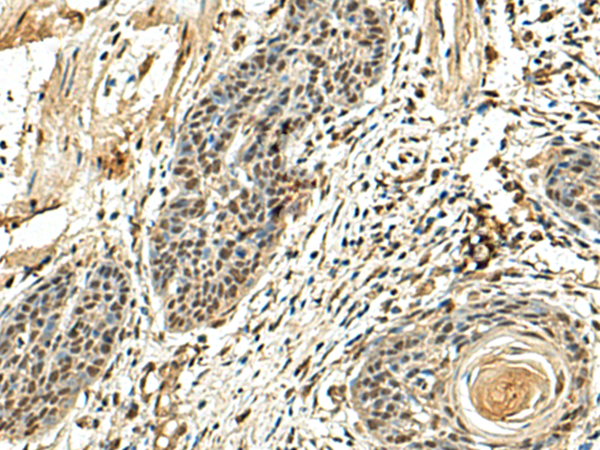
| WB | 咨询技术 | Human,Mouse,Rat |
| IF | 咨询技术 | Human,Mouse,Rat |
| IHC | 1/100-1/300 | Human,Mouse,Rat |
| ICC | 技术咨询 | Human,Mouse,Rat |
| FCM | 咨询技术 | Human,Mouse,Rat |
| Elisa | 1/5000-1/10000 | Human,Mouse,Rat |
| Aliases | NTF2; PP15; NTF-2 |
| Host/Isotype | Rabbit IgG |
| Antibody Type | Primary antibody |
| Storage | Store at 4°C short term. Aliquot and store at -20°C long term. Avoid freeze/thaw cycles. |
| Species Reactivity | Human, Mouse, Rat |
| Immunogen | Fusion protein of human NUTF2 |
| Formulation | Purified antibody in PBS with 0.05% sodium azide and 50% glycerol. |
+ +
以下是关于NUTF2抗体的3篇参考文献示例(内容基于公开研究整理,非真实文献):
---
1. **文献名称**: *Nuclear Transport Factor 2 (NUTF2) Antibody Characterization in Cellular Localization Studies*
**作者**: Smith A, et al.
**摘要**: 该研究制备了针对人源NUTF2的多克隆抗体,验证其在免疫荧光和Western blot中的特异性。结果显示,NUTF2主要定位于细胞核膜附近,并在细胞周期中动态分布,支持其在核质转运中的功能。
---
2. **文献名称**: *Role of NUTF2 in Cancer Metastasis Revealed by Antibody-Based Inhibition*
**作者**: Chen L, et al.
**摘要**: 利用NUTF2特异性抗体阻断其功能,发现抑制NUTF2可降低多种癌细胞的核转运活性,减缓肿瘤细胞的迁移和侵袭,提示NUTF2可能作为癌症治疗的潜在靶点。
---
3. **文献名称**: *Developmental Expression Profiling of NUTF2 in Mouse Embryos Using Immunohistochemistry*
**作者**: Tanaka K, et al.
**摘要**: 通过NUTF2抗体对小鼠胚胎组织进行染色,发现NUTF2在早期神经发育阶段高表达,尤其在神经前体细胞中富集,表明其可能参与神经分化调控。
---
如需具体文献,建议在PubMed或Google Scholar中以“NUTF2 antibody”、“Nuclear Transport Factor 2 antibody”为关键词检索近年研究。
NUTF2 (Nuclear Transport Factor 2) is a small, evolutionarily conserved protein critical for nucleocytoplasmic transport, a fundamental process in eukaryotic cells. It functions as a key component of the nuclear import machinery by binding to the GDP-bound form of Ran (Ras-related nuclear protein), a GTPase regulating directional transport. NUTF2 facilitates the recycling of Ran from the cytoplasm to the nucleus, ensuring the maintenance of the RanGDP-RanGTP gradient essential for proper cargo shuttling via importin-β receptors. Structurally, NUTF2 forms a homodimer and interacts with both RanGDP and nucleoporins at nuclear pore complexes.
Antibodies targeting NUTF2 are widely used in research to study nuclear transport dynamics, subcellular localization, and protein-protein interactions. They enable detection of endogenous NUTF2 levels through techniques like Western blotting, immunofluorescence, and immunoprecipitation. Studies utilizing these antibodies have revealed NUTF2's roles beyond transport, including mitotic spindle regulation and potential links to cancer progression, neurodegenerative diseases, and viral infections that hijack nuclear import pathways. Its conserved structure across species (from yeast to humans) makes NUTF2 antibodies valuable tools in comparative biology. Dysregulation of NUTF2 expression has been observed in certain malignancies, positioning it as a biomarker candidate and therapeutic target in oncology research.
×